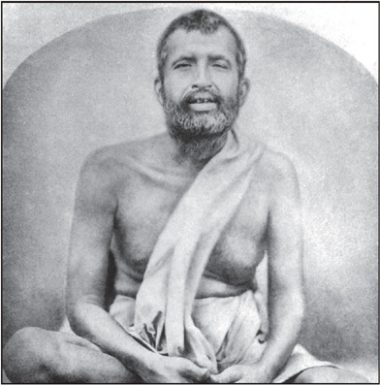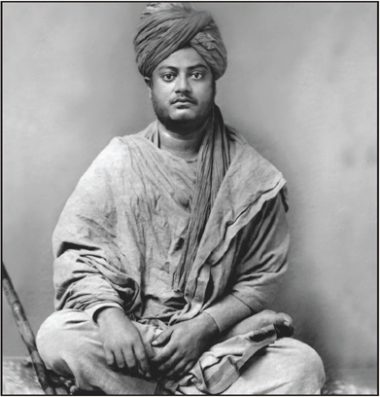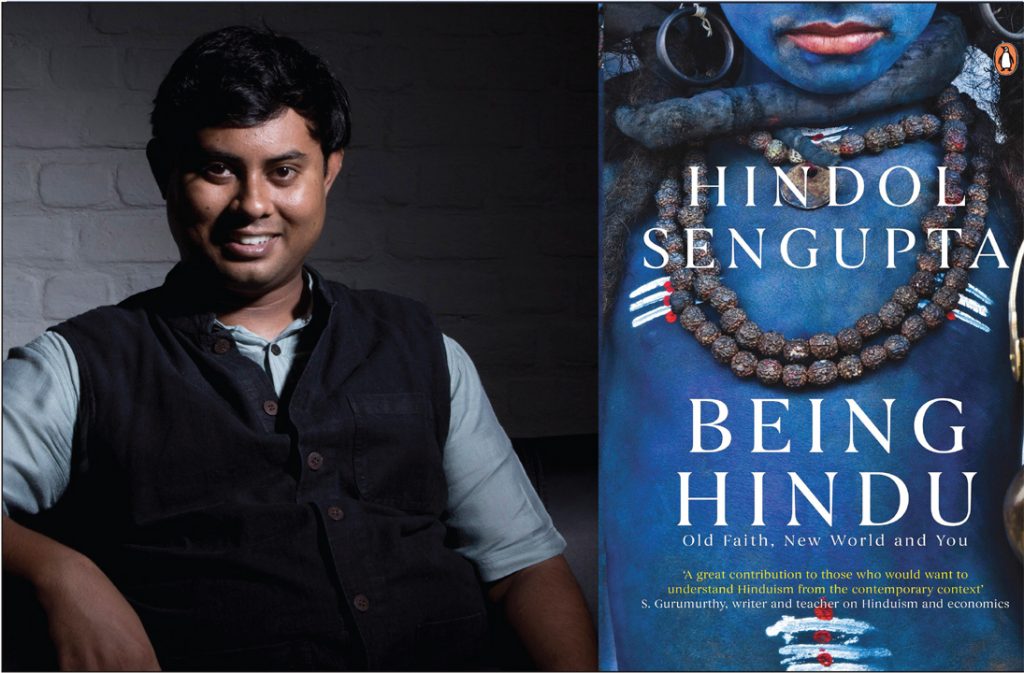Demystifying Hinduism for the Next Generation
Hindol Sengupta thinks out loud with a bold narrative that stands strong for Hinduism and proclaims, “You are not a sinner. You are divine.”
“PROGRESS CANNOT TRANSPIRE UNLESS Hindus first understand who they are, where they come from and where they are going.” So writes Hindol Sengupta—journalist, entrepreneur, editor-at-large at Fortune India and author of eight books. He continues, “There has been a myth in India that Hindus do not, ever, place their moral and political superstructures and points of view in the philosophies of their faith. This is untrue, and one of the people who really understood this reality was Gandhi. His infusion of Hindu belief systems, idioms, iconography and commitment to plurality, which came directly from the core principle of the Rig Veda—ekam satviprah bahuda vedanti (truth is one, the sages describe it variously)—lifted the moribund Indian National Congress from a tepid, elite debating society to a fervent national movement.”
Being Hindu was released in 2015 by Penguin Random House, India, and quickly made a name for itself as being Hindol’s best-selling work. His approach? Keep it simple. Sengupta is well educated, with a bachelor’s degree in journalism and a master’s in mass communication from the A.J.K. Mass Communication Research Centre, but his writing on Hinduism is clear and approachable. Keeping his skeptical Indian audience in mind, Sengupta wrote Being Hindu for the all-too-common Indian youth who has grown up inside the religion as a way of life, but never awakened to its deeper meaning.
Who, What, When, Where and Why?
The story of Sengupta’s path from childhood begins in the Americana of the Assembly of God Church School in Calcutta. He quickly defines what a typical Indian youth experiences in the throes of Christian schooling. “During mass each day,” Sengupta remembers, “different pastors solemnly walked up and stood on the large stage before us, holding fat Bibles full of Post-it notes. The pastors would tell us stories from the Bible and the moral lessons those stories held…. There were giants and heroes with swords flashing in them. The young David with a sling before Goliath, the hair of Samson that was the secret to his magical strength, Jesus miraculously multiplying bread and fish—it all seemed familiar,” he says, reflecting on his grandmother’s tales from the Mahabharata and Ramayana.
A now older and wiser Sengupta continues, “What we did not understand for many years was the deeper message. We did not comprehend that something else was being said to us.” This was the idea that “to not believe in Jesus was to be a sinner.”
Fast forward several years, and the reader is introduced to a self-explored man who has grown up yearning to know more about the religion of his family and of his country. The chapters, broken into digestible topics, follow Sengupta’s evolution of reflection and insight, study, contemplation and research on Vedanta. From how the book was inspired, to whom the author is trying to reach, Sengupta plots his Hindu path with sections about who and what is a Hindu, when and where Hinduism lives and why it has persisted throughout history.
Prodded by the author’s brazen Hindu perspective, the reader can learn much about Indology—the study of Indian history, literature, philosophy and culture—throughout the book. Sengupta starts at the basic level when he writes, “The Persians, who considered the River Sindhu (Indus) as one of the boundaries to their empire, supposedly could not manage the “s” in the river’s name and replaced its pronunciation with an “h” to suit their own tongue. So it became that everyone who lived south of the Sindhu (now Indus) came to be called Hindu.”
On the ancient Hindu concept of meaning, Sengupta starts to unravel the complex nature of what we comprehend as the eternal truth. “One of Hinduism’s oldest and most revered hymns, sung ceaselessly every morning by thousands for perhaps 3,000 years—perhaps more—the Gayatri Mantra, is a prayer for illumination, for radiance, for knowledge, for that intelligence which is eternally enlightening. One of the earliest and most convincing devotional pleas was for intelligence. Not material blessings, not refuge, not solace, not providence, but intelligence.”
After defining the basics of Hindu beginnings, common Hindu thought and what really makes a Hindu, Sengupta ends the first section of the book with a soul-gripping message that is left out of far too many Hindu narratives. “The idea that man can invoke Divinity in clay (any idol) to make it God and then worship it is, to me, the most sublime idea of the potential in each of us; the idea that not one of us is condemned. Not one of us needs saving or an external aid.
“All that we seek, all that we will ever need and could ever need lies within us. None of us is a heathen. None of us is an infidel. Not one of us is an unbeliever, for how can you be an unbeliever in yourself? There are no false Gods, because how can that which lies within you, which you worship, be false to you? How can you be false to yourself?
“You and me, we are manifestations of God. We are God; we just don’t know it yet…You and me, we are not sinners. We are the Divine, we just don’t know it yet.”
On Vegetarianism
One chapter of Being Hindu is entitled, “Does Being Hindu Mean You Are Vegetarian?” Sengupta’s answer is no. His point is that Hinduism is traditionally and historically accepting both of vegetarians and meat eaters. For the latter, he cites the example “the ultimate modernist in Hinduism,” Swami Vivekananda, who hailed from Bengal, where vegetarianism is historically rare. He also quotes Mahatma Gandhi—a vegetarian for most of his life—who pointed out: “Unfortunately today Hinduism seems to consist merely in eating and not eating. Hinduism is in danger of losing its substance if it revolves itself into a matter of elaborate rules as to what and with whom to eat. Abstemiousness from intoxicating drinks and drugs, and from all kinds of foods, especially meat, is undoubtedly a great aid to the evolution of the spirit, but is by no means an end in itself.”
Sengupta attributes the teaching of nonviolence—the ethic upon which vegetarianism is based—to the Buddha, failing to note that non-injuriousness, is an ancient Hindu ethic, clearly mandated in Yajur Veda 12.32: “You must not use your God-given body for killing God’s creatures, whether they are human, animal or whatever.” Further, the Mahabharata explains, “there are three forms of killing: he who brings flesh or sends for it, he who cuts off the limbs of an animal, and he who purchases, sells, or cooks flesh and eats it.”



Why We Need Religion
Being Hindu ends with a powerful call to defend oneself from materialism and to save oneself from a loss of meaning and purpose.
“How many Hindus really know why they pray? What do the mantras mean, and why do they mouth them? No one taught us to understand that the act of prayer is really inward, not outward, and that in the act of seeking all you can ever hope to receive is the understanding of that which lies within you.
“We grow up believing that to pray is to reach out to the external, that which lies outside of us. All the while, in reality, we are seeking something that lies within us…What is prayer if not a lesson in the profound power of vulnerability? Prayer teaches us that to be vulnerable is to be human, even alive.
“But the idea that one prays for external sustenance is not the basis of the Sanatan Dharma. Wonderfully, if you contemplate this, Hinduism teaches that your prayers are truly directed, in a sense, to yourself. You are praying to yourself. So, I felt that understanding how we relate to God is far from futile. Understanding how you relate to the idea which you turn to, sometime perhaps almost embarrassingly in your most helpless moments, can hardly be useless. In fact, it is entirely seminal in our individual journeys. It is only through this travel that we come to appreciate that there isn’t one individual journey; it is the manifestation of the larger path the universe takes.”
Being Hindu, 192 pages, softbound, ISBN 978-0-143-42532-8. Available via Amazon at bit.ly/being-hindu
